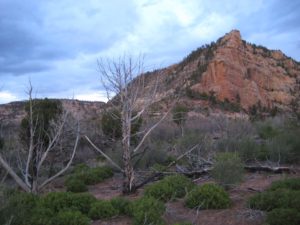 We were all still covered in brown paint and dirt from the activities of the previous days when we met with Mark Sorensen in a dimly lit school room. Mark is the founder of an off the grid charter school near the Navajo Reservation called the Star School, where students are not only taught mandatory U.S. curriculum but about Navajo language and culture and the importance of environmental thinking. We stood in a circle in the middle of the room and passed around a small bag of corn pollen. Our fingers that had painted outbuildings, constructed a cob oven, and shaped rock gardens dipped in to take a pinch of the delicate powder. They brought fine gold to touch the tips of our tongues, the center of our foreheads, and the crown of our hair. The remaining pollen that stuck to these fingers was sprinkled in front of us as we spoke the Navajo words “Hozho nahaste.” We were told to think beautiful thoughts about the path that lay before us during this process as the ceremony is a blessing for safe and happy travels.
We were all still covered in brown paint and dirt from the activities of the previous days when we met with Mark Sorensen in a dimly lit school room. Mark is the founder of an off the grid charter school near the Navajo Reservation called the Star School, where students are not only taught mandatory U.S. curriculum but about Navajo language and culture and the importance of environmental thinking. We stood in a circle in the middle of the room and passed around a small bag of corn pollen. Our fingers that had painted outbuildings, constructed a cob oven, and shaped rock gardens dipped in to take a pinch of the delicate powder. They brought fine gold to touch the tips of our tongues, the center of our foreheads, and the crown of our hair. The remaining pollen that stuck to these fingers was sprinkled in front of us as we spoke the Navajo words “Hozho nahaste.” We were told to think beautiful thoughts about the path that lay before us during this process as the ceremony is a blessing for safe and happy travels.
Hozho Nahaste roughly translates to beautiful pathway, but there is much more implied when this phrase is spoken. As Gary Witherspoon explains in his paper “Creating the World through Language,” hozho expresses such concepts as beauty, perfection, harmony, goodness, normality, success, well-being, blessedness, and order.” Witherspoon uses the next four pages to discuss the cultural frame of reference that is expressed through a single word. To a speaker of Navajo, hozho evokes all of the meaning and emotion that builds up over the centuries it takes for cultures to evolve.
The path set before me led to the Dark Canyon Wilderness in Southern Utah. As the weight of my pack pulled on my body, thoughts of the weight single words can carry were on my mind. We made our way down canyon and passed through clouds of vanilla wafting off of ponderosa pines that towered over blankets of purple, pink, and orange wildflowers. It wouldn’t have felt like the Colorado Plateau if not for the sandstone cliffs creating the backdrop for this vegetation. Beauty. Perfection. Harmony. These words are Dark Canyon Wilderness just as much as they are hozho.
The word wilderness was once used to describe places of danger and fear. It was a place where brave folks went to conquer the land and tame it for human use. Presently, the word is given a capital “W” and describes lands that are pristine and remote. Humans are considered visitors here with the thought that their permanent presence will disturb natural systems. People enter the wilderness for healing and peace of mind. We found this in clear deep plunge pools and fossil-filled limestone over the next few days as we descended into Dark Canyon. “Did you guys notice when we crossed the wilderness boundary?” our instructor asked on day four. None of us had. We never would have known that the land we walked across was defined as something besides wilderness if we hadn’t been told. I still felt hozho on this path.
What does this human-made boundary mean? As far as I could see, it signified an arbitrary sense that some lands are more worth protecting than others, a sense that can be justified through creating a distinction between the human and non-human world. My path led me to the fiery blossom of a claret cup cactus in the wilderness. It led me to the vibrant green of moss that carpets the sandstone stream bed. It flourishes under the glossy finish of sunlight on shallow water, and it lies outside of wilderness. I walked along my path as a part of the Dark Canyon system, as my steps compacted the soil where plants might have grown and my breath contributed to the carbon cycle. Definitions have warped our views on what is worth saving. Where do you experience hozho? Is it worth preserving?